When you’re out enjoying your camping trip, there’s no reason for the fun to come to an end as the sun goes down. With some creative lighting ideas you can keep the party going late into the evening and make your campsite feel more like home. While you can use a flashlight and/or headlamp (and you should have these in your camping gear), strategically placing different kinds of camp lighting around is a more convenient and comfortable way to illuminate your nights so you can cook dinner, enjoy some libations, play games, and enjoy yourselves after sunset.
When it comes to outdoor lighting you can’t beat a combo of solar powered and battery powered light sources. Solar-powered lights are great to help save on batteries but they aren’t as effective on stormy or cloudy days, so having battery-powered lighting to act as a backup is a wise decision (especially if you bring along a rechargeable battery pack and a way to charge these batteries).
Fortunately, there are many creative and effective ways to utilize camp lighting. Below, you’ll find a list of campsite lighting ideas.
Contents
Camping Lanterns
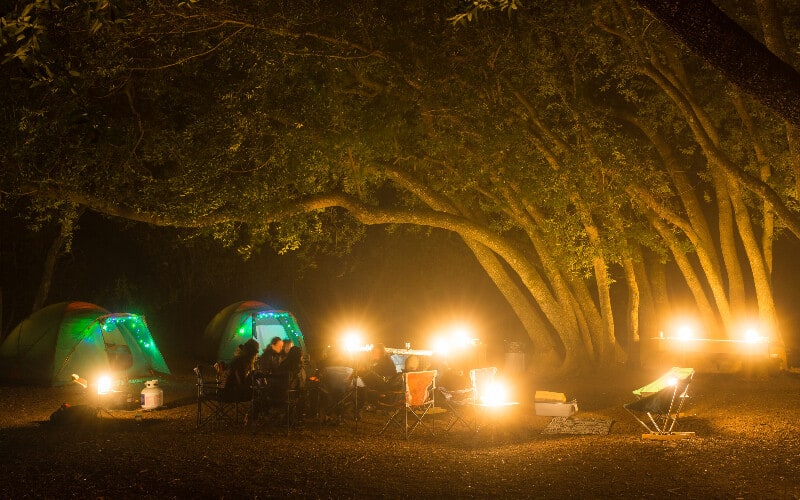
Having lanterns scattered around your campsite can really improve your adventures after dark. You can choose from several choices, such as an electric lantern or a fuel-burning camping lantern. You can set your lanterns on the ground, or if you have room you can bring along camping lantern poles to hang them up around and throughout your campsite. When it comes to choosing the right camp lantern, you have several options to consider: fuel source, weight, size, and price.
Electric Lanterns

Most battery-powered options available on the market are LED lantern solutions, which means they use very little power while emanating bright light. An LED camping lantern has many benefits, including the fact that they are usually lightweight and can be used safely inside tents.
Battery-Powered Lantern
However, if you choose an electric lantern that runs on batteries, it’s a good idea to consider bringing along a rechargeable battery pack that you can recharge with a solar charger during the day. An LED camping lantern can be used for anywhere from 12 hours to 100+ hours depending on which model you choose, so it’s important to do your research before purchasing, and know how much power you’ll need to operate them based on the length of your camping trip and estimated usage.
A few downsides of a battery operated lantern are: battery disposal and battery cost over time (if you’re not using rechargeable batteries), and recharge time if you’re on a trip that spans more than a day or two.
Rechargeable Lantern Options
Some options have built-in battery banks, so a rechargeable lantern can be a great option if you know you’ll be able to access power.
Solar Lantern
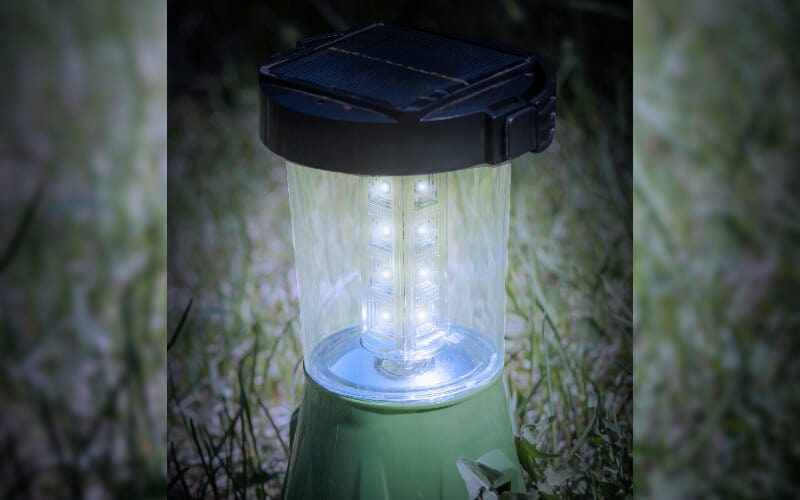
Other options have a solar panel built in, and a solar lantern can be handy as long as you have plenty of sunlight on your trip. A solar powered lantern will usually fully charge in 6-8 hours, and should last about that long before needing a recharge.
Here’s a list of the best electric lanterns on the market.
Fuel-Burning Lanterns

An alternative to electric power is a gas powered lantern, such as a propane lantern or a butane camping lantern. These types of lanterns are often more bright than LED lantern alternatives, as many models can light up your entire campsite (where you might need multiple electric lanterns to achieve a similar level of illumination with LED light).
Another benefit of these lanterns is that they are often more adjustable than their electric counterparts, and they can burn for long periods of time. They’re reliable (a Coleman lantern is about as a dependable as a camp lantern can get) and you don’t have to worry about whether or not your batteries are going to run out unexpectedly.
A few downsides of almost any gas lantern are: they’re heavier and less portable than electric options, you’ll need to haul some extra fuel with you (a propane lantern needs a propane canister, a butane lantern needs a butane canister, etc.), a gas powered lantern usually costs more, and they aren’t safe to use in enclosed areas such as a tent. Also, a gas lantern tends to generate a faint buzz or hissing noise, which can be irritating to some.
Click here to see the best gas-powered lanterns.
Candle Lanterns
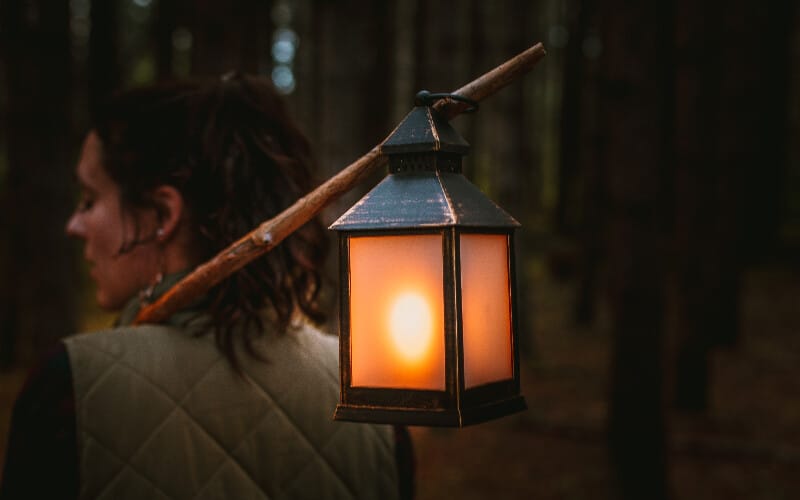
A candle lantern is another popular lighting choice for campsites, and for good reason. For lighting in the camping lantern category, they’re lightweight and don’t require carrying extra fuel with you, plus they’re relatively cheap.
However, they don’t cast light nearly as far as electric or fuel-based options, and you’ll need to carry extra candles in your bag. They do, however, create a nice soft glow if you’re looking for a relaxing ambiance, which is a benefit unless you’re needing light to do more labor-intensive tasks after dark.
Additionally, the candles used as the light source can present a hazard, so it’s important to keep them away from flammable objects such as your tent and sleeping bag.
We’ve reviewed the best candle lantern options here.
Mason Jar Lanterns

When it comes to campsite lighting ideas, the more creative you can get, the better! Lanterns are a popular campsite lighting option, but they can be expensive. Candles and mason jars are another great combination for illuminating your campsite–and they’re much cheaper. Instead of bringing multiple bulky lighting sources, you can use an assortment of recycled mason jars to light your campsite with a candle in each.
Mason jars come in all different shapes and sizes, and while you can buy expensive or fancy glassware, you can also easily find glass jars (and candles!) at your local dollar store to use.
Just keep in mind that while mason jars and candles are a cheap camping light option, they’re fragile and can break easily–so they aren’t a great option if you’re hiking to your campsite. They can also present a flame hazard, so you shouldn’t use these in or near your tent (or near any other flammable items).
Glow Sticks
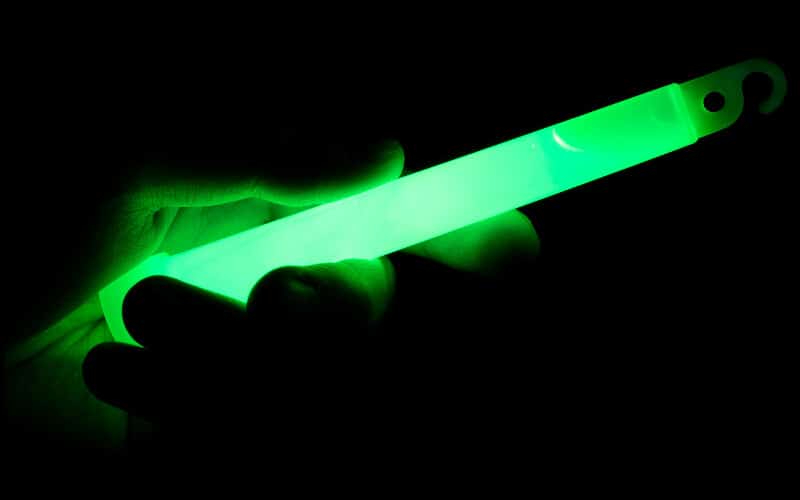
Glow sticks are another favorite light source among campers of all ages. These versatile lights come in a variety of shapes and colors and can be used in a number of creative ways to create a fun atmosphere for your campsite after dark.
Staking in the Ground
Tripping is never enjoyable, and it’s a lot easier to trip when it’s dark out. Prevent tripping and avoidable injuries by sticking glow sticks in the ground to mark tent ropes and stakes, exposed tree roots, coolers, and other objects that can present a hazard in the dark.
In Jars & Bottles
Glow stick lanterns are cheap, easy, and effective. Any mason jars or old bottles will work, simply fill them with water and place an activated glow stick inside before sealing. These lanterns aren’t as bright as more traditional lanterns, but the water amplifies the light and they’ll glow for about 12 hours. They’re also safe and fun to illuminate the inside of your tent with, which is an advantage over candles and fuel-based lights. (A battery-powered LED bulb can be used instead of a glow stick in a mason jar with a similar effect).
Hanging Glowsticks from Trees
Suspending glow sticks overhead from tree branches is another fun way to spice up your camping trip. All you need is some string, a few glow sticks, and some branches overhead. Run the string through the glowsticks and toss them over the branches–just be sure to remove them and the rope before departing. If you have enough glow sticks you can even make a glow stick chandelier!
Glow Stick Fun & Games
In addition to providing relaxing and fun ambient lighting, glow sticks can also be great for evening game time! From bowling to frisbee, there are dozens of ways to use glowsticks to add even more fun to your trip. Make up your own games, or get some inspiration from our Camping Glow Stick Party Games guide.
Tiki Torches
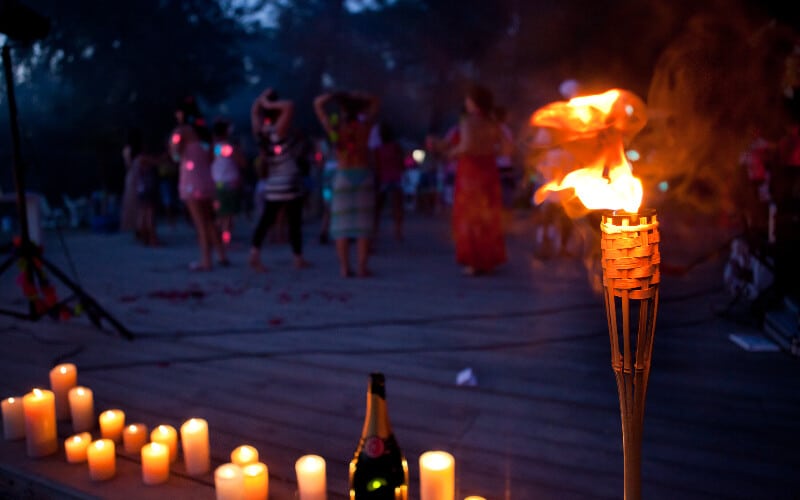
Tiki torches can serve multiple purposes in your campsite–not only are they a fun source of light that can make your trip more relaxing, they can also help keep away bugs when filled with citronella-infused torch fuel. Standard size tiki torches can be a bit tall and cumbersome, so they may not be a great choice if you’re planning on hiking to your campsite or if you’re limited on space for any reason.
However, there are mini tiki torches that are created for table tops that give off a similar vibe–while being easier to carry and transport. Just keep in mind that any size tiki torch can present a fire hazard, so it’s important to keep them away from tents, trees, bushes, and other flammable objects; be sure to extinguish them before you leave through your campsite.
Citronella Candles
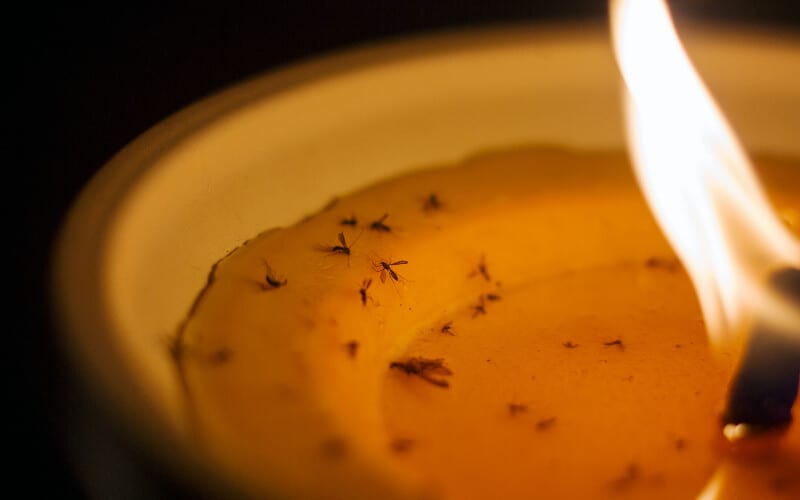
Alternatively (or in addition) to tiki torches, citronella candles are another popular and effective light source for your campsite. The wicks tend to be much smaller so they won’t burn as bright as tiki torches, but they’re great for illuminating your table to eat, play card games, read, etc. They also tend to be more portable than tiki torches (even the mini torches), and can help repel mosquitos and other pesky insects.
String Lights
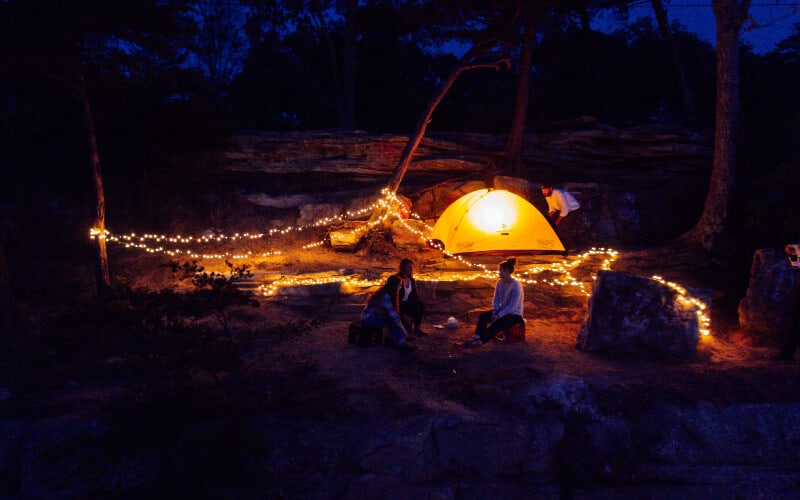
String lights are another common lighting solution that you can use around your campsite to create a fun, bright, and relaxing atmosphere. These camping string lights are generally made up of a series of LED light bulbs or incandescent bulbs, and are powered by either battery, solar light, or a standard wall outlet plug.
Christmas lights are a common form of string light, and they’re a popular lighting solution as far as camping string lights go. If you celebrate Christmas or any other holiday where you hang lights around your house, you can save some and spruce up your campsite with them instead of buying all new lights! If you don’t, however, these lights are fairly cheap and can really add to your camping experience.
If you’re going to bring these types of lights, it never hurts to have an extra LED bulb or two to replace a burned bulb (or an incandescent bulb or two if using incandescent lighting).
Battery-Powered String Lights

Alkaline batteries can efficiently power string lights of varying sizes for all or most of an evening. Be sure to read the box of the lights you want to bring on your trip to ensure you have enough batteries (and consider rechargeable batteries if you can utilize solar light panels to recharge them during the day).
Generally, incandescent battery-powered string lights can last between 6-12 hours with C or D batteries, and 4-6 hours on a pair of AA batteries. LED string lights can last for 16-24 hours on a set of AA batteries depending on their length and number of bulbs.
If you’re going to use battery-powered string lights, calculate your you estimated total hours of usage and bring enough AA battery, C, or D battery replacements to last through your trip.
Solar-Powered String Lights
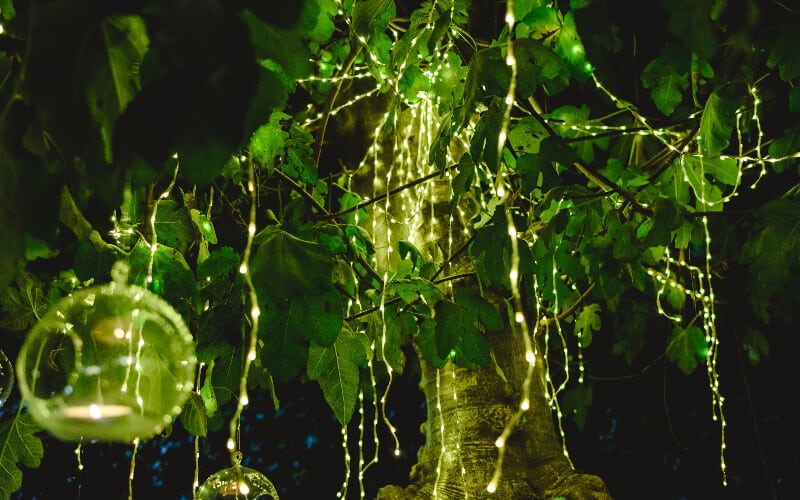
Some string lights have solar panels built in so you can harness the power of the sun with minimal effort. Just make sure that you place the panels in sunny locations and be aware that if the forecast is projecting cloudy days it won’t be able to charge as quickly or as well, which means your lights may not last quite as long through the evenings.
If your lights use a plain power outlet plug and you have a nearby power source (such as an RV or camper, or if you’re car camping) you may be able to power them and keep your string lights running from dusk until bed time that way. If not, you can purchase a solar power battery bank and plug your lights into it.
Rope Lights
Rope lights are a great alternative to, or supplement for, string lights. They’re low-power, easy to hang around your campsite (wrap them around tree trunks, branches, tables, and tents), come in a variety of colors, and hold up well against rain and the elements. They’re also affordable, portable, and reliable.
Similar to string lights, these lights can be incandescent or an LED strip and can be powered by batteries, solar power, or with power drawn from a camper.
Solar Camping Lights
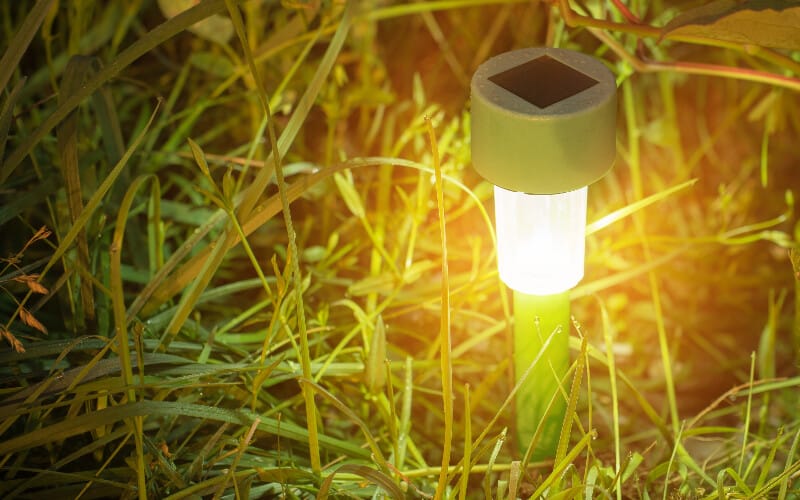
Solar camping lights come in a variety of options, from lanterns to rope lights, string light options, LED strips, fixtures, and more.
You may prefer a solar powered lantern over a battery operated lantern, which can help save on battery and fuel costs over time. But if you have other lights that aren’t solar light, you can utilize a solar panel and power banks to capture and store energy during the day, while plugging your lights in at night. Alternatively (or in addition), you can bring along rechargeable batteries and charge them during the day with your solar panels.
Fortunately solar panels are cheap and portable, so they’re worth the small investment if you can work them into your budget. Here’s an overview of the best portable solar panels available.
Dangers of Propane and Gas Lights

While fuel-burning light sources can be handy, it’s important to stay alert and safe when utilizing them. Popular choices such as a Coleman lantern can provide a lot of light, but using them in your tent or in a confined space can lead to a buildup of carbon monoxide, which can be deadly. These fumes are colorless and odorless, making them even more dangerous.
Additionally, this type of camping lantern uses a flame to create light, so there’s always a fire hazard present. Because of this, it’s important to extinguish these lanterns when you aren’t near them.
Lighting Inside Your Tent

Campsite lighting ideas don’t apply exclusively to your campgrounds–you’ll want to light up your tent as well! Sure, you could scrape by with nothing but a handheld flashlight or headlamp to illuminate your tent when you need to rummage through your camping gear after dark, but camping should be a comfortable experience, and there’s better ways to enjoy your time in your tent.
As mentioned earlier, a camping lantern is a great way to illuminate your tent (as long as it’s electric or or solar powered), or you can go with glow sticks or other safe sources of light. However, it’s worth checking the best tent lighting options on the market, as some have an LED camping light along with extra features to make your tent more comfortable.
Investing in an LED camping light solution for your tent can make it feel less like a temporary shelter & more like a home.
Lighting When You’re on the Go

Whether you plan on doing some hiking, want to explore the current area, or need to scavenge around for more firewood as the sun is setting, having some powerful, lightweight & portable lighting is important. Ideally you’ll have one or more flashlights on hand, and a headlamp to help when you need to use both hands (gathering firewood, etc.).
Click here for a list of the best flashlight options on the market, and click here for an overview of the best headlamps available.
Campsite Lighting Ideas: Wrapping Up
As you can see from the options outlined above, you have a lot of choices when it comes to illuminating your campgrounds on your next adventure. With a little planning ahead you can decide which types of camping lighting will work best (if you’re car camping or staying in an RV or camper you’ll have more options than if you’re hiking, for example). The key is to be creative and factor in how much energy you’ll need to keep the lights on and decide which types of power sources will work best for your outdoor lighting. If you’re going to use battery power for your lights, make sure you have enough alkaline batteries, and the right size batteries (don’t bring an AA battery if you need C or D, etc.). If you’re planning on using solar power, make sure you have enough solar panels and power banks to store up energy.

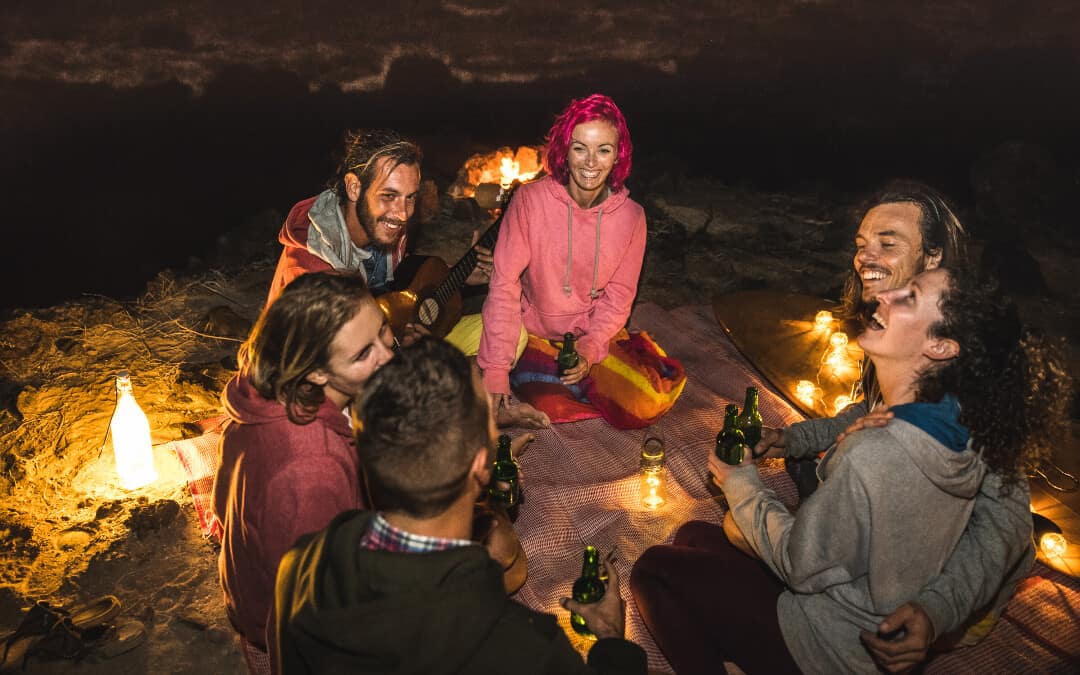
0 Comments